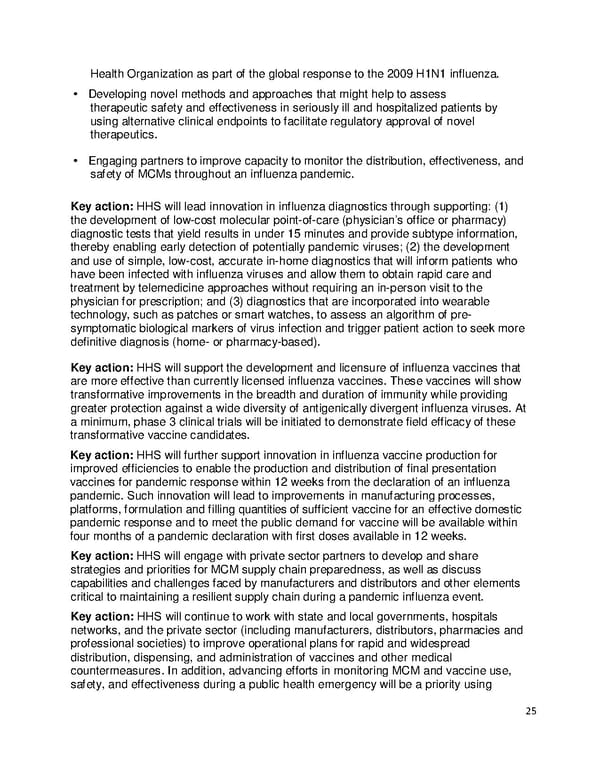Health Organization as part of the global response to the 2009 H1N1 influenza. • Developing novel methods and approaches that might help to assess therapeutic safety and effectiveness in seriously ill and hospitalized patients by using alternative clinical endpoints to facilitate regulatory approval of novel therapeutics. • Engaging partners to improve capacity to monitor the distribution, effectiveness, and safety of MCMs throughout an influenza pandemic. Key action: HHS will lead innovation in influenza diagnostics through supporting: (1) the development of low-cost molecular point-of-care (physician’s office or pharmacy) diagnostic tests that yield results in under 15 minutes and provide subtype information, thereby enabling early detection of potentially pandemic viruses; (2) the development and use of simple, low-cost, accurate in-home diagnostics that will inform patients who have been infected with influenza viruses and allow them to obtain rapid care and treatment by telemedicine approaches without requiring an in-person visit to the physician for prescription; and (3) diagnostics that are incorporated into wearable technology, such as patches or smart watches, to assess an algorithm of pre- symptomatic biological markers of virus infection and trigger patient action to seek more definitive diagnosis (home- or pharmacy-based). Key action: HHS will support the development and licensure of influenza vaccines that are more effective than currently licensed influenza vaccines. These vaccines will show transformative improvements in the breadth and duration of immunity while providing greater protection against a wide diversity of antigenically divergent influenza viruses. At a minimum, phase 3 clinical trials will be initiated to demonstrate field efficacy of these transformative vaccine candidates. Key action: HHS will further support innovation in influenza vaccine production for improved efficiencies to enable the production and distribution of final presentation vaccines for pandemic response within 12 weeks from the declaration of an influenza pandemic. Such innovation will lead to improvements in manufacturing processes, platforms, formulation and filling quantities of sufficient vaccine for an effective domestic pandemic response and to meet the public demand for vaccine will be available within four months of a pandemic declaration with first doses available in 12 weeks. Key action: HHS will engage with private sector partners to develop and share strategies and priorities for MCM supply chain preparedness, as well as discuss capabilities and challenges faced by manufacturers and distributors and other elements critical to maintaining a resilient supply chain during a pandemic influenza event. Key action: HHS will continue to work with state and local governments, hospitals networks, and the private sector (including manufacturers, distributors, pharmacies and professional societies) to improve operational plans for rapid and widespread distribution, dispensing, and administration of vaccines and other medical countermeasures. In addition, advancing efforts in monitoring MCM and vaccine use, safety, and effectiveness during a public health emergency will be a priority using 25
 Pandemic Influenza Plan Page 24 Page 26
Pandemic Influenza Plan Page 24 Page 26